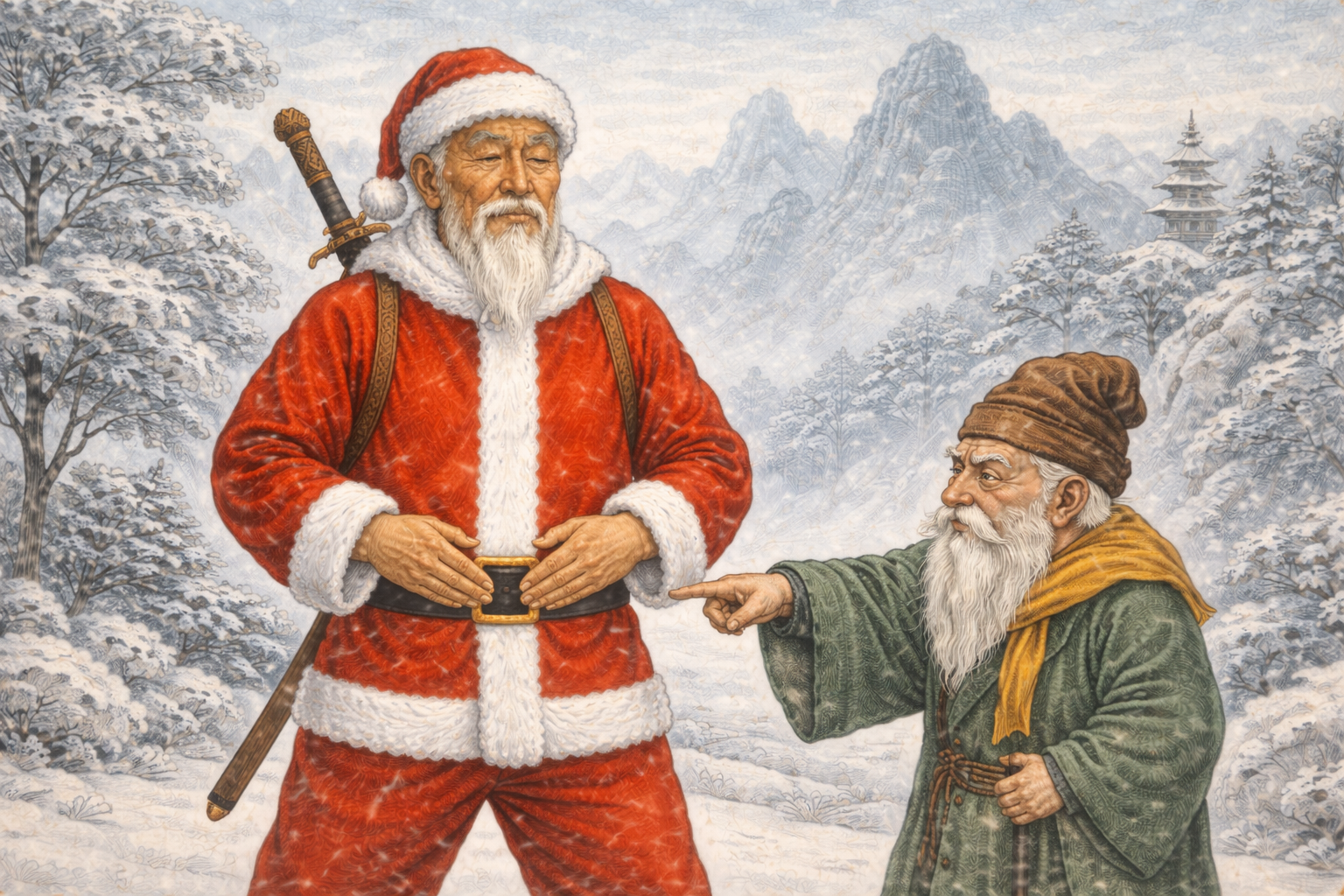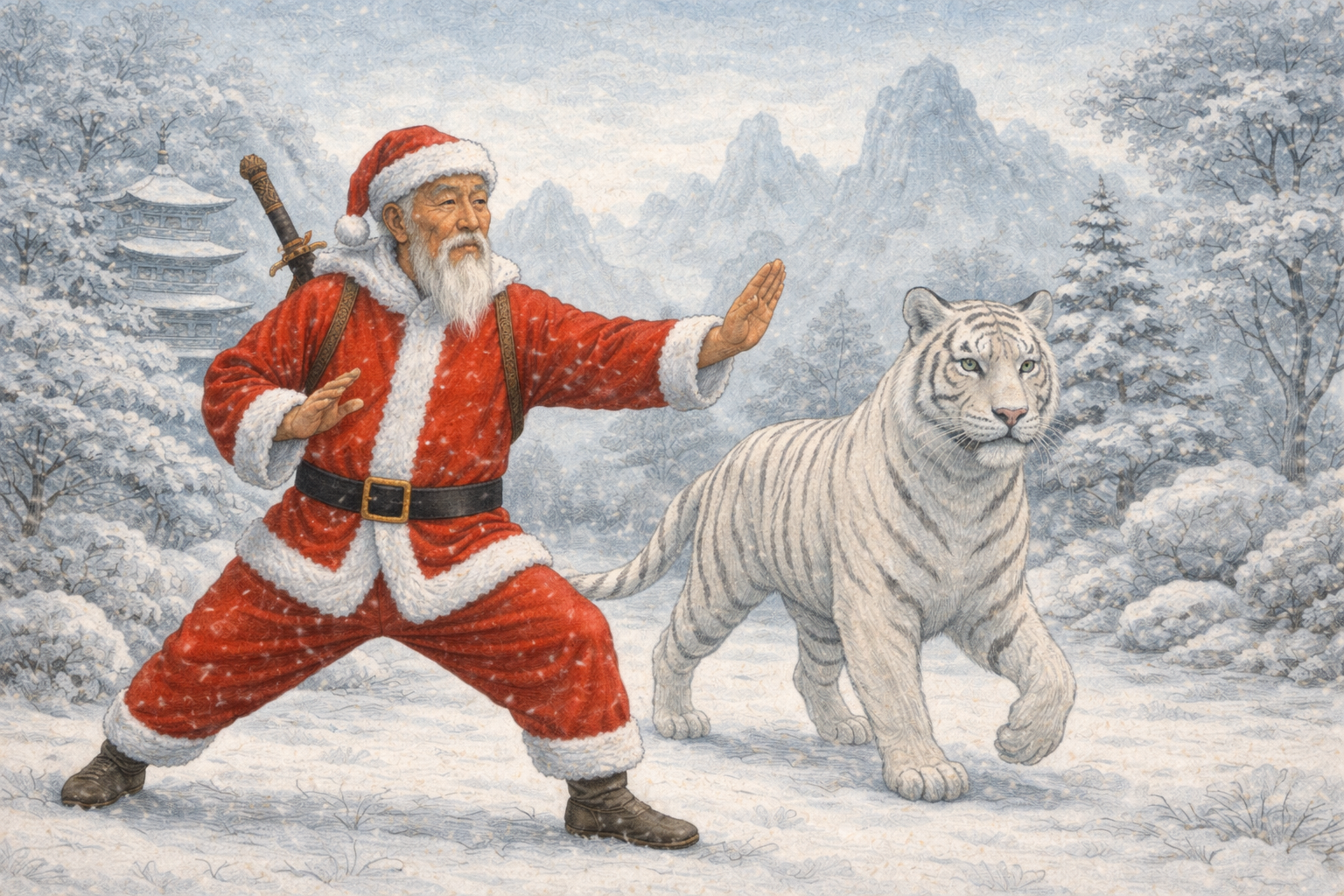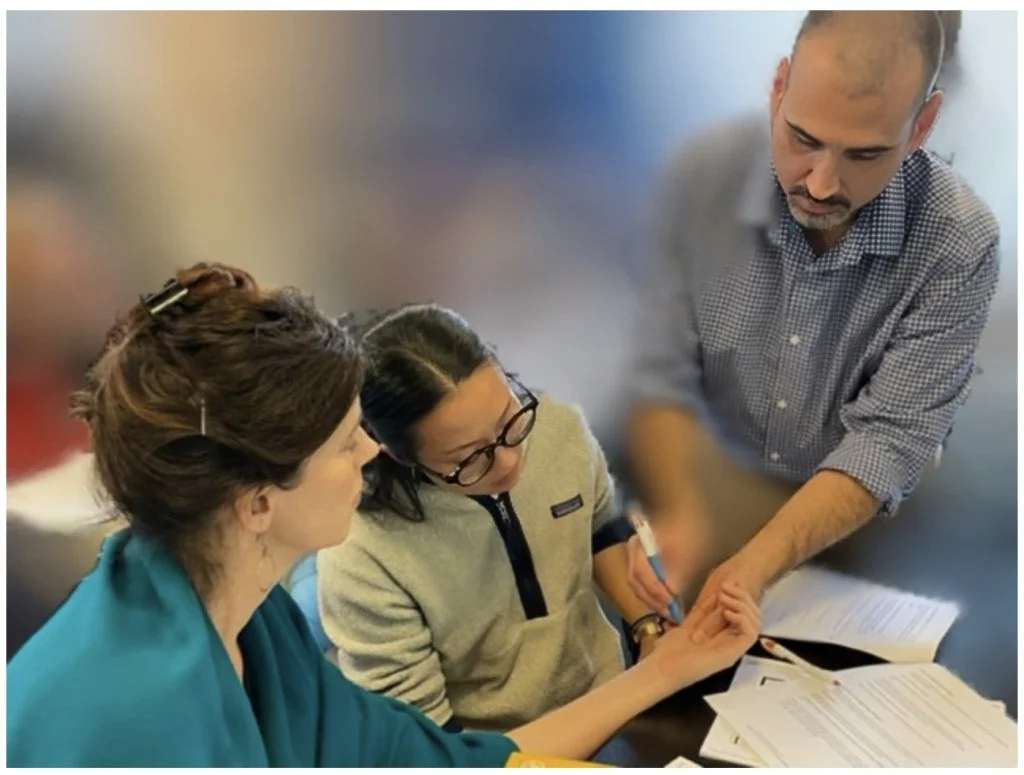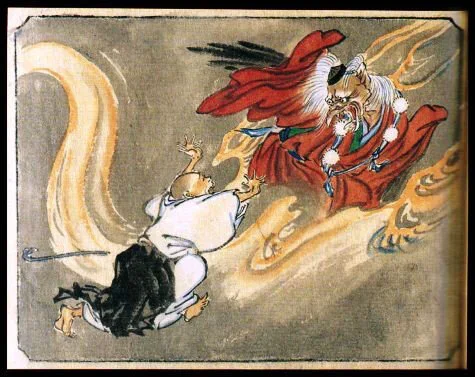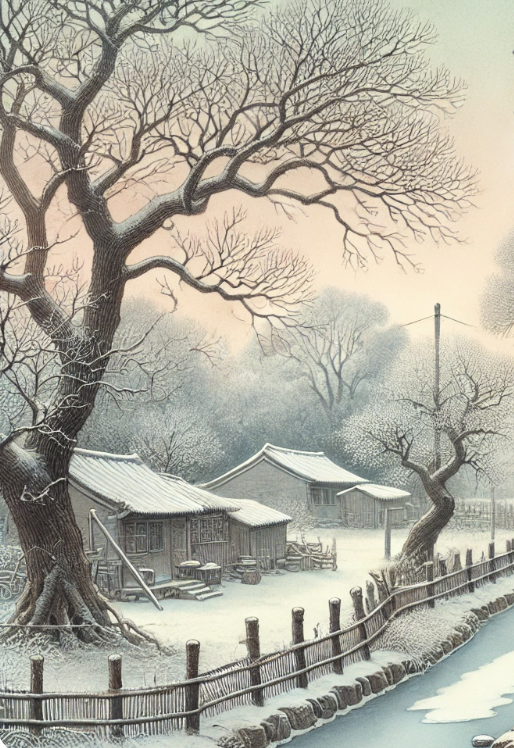Here in northern New Jersey we woke to a snowier morning than I was expecting. A thin but substantial layer of white blanketed everything. And as is typical of those early snowy mornings, it was quiet and still. Things moved a little more slowly, and even our morning Qigong session at 8am didn’t really start until 10 or 15 minutes after that.
Today is quite a special day. Earlier this morning at 4:21am Eastern Time we reached one of the most important astronomical events of the solar year – the Winter Solstice. This day is the natural embodiment of post tenebras lux, as it is the literal as well as metaphorical return of light. Thus, Solstice is the original Winter holiday, and the basis for why other holidays – Christmas, Julian Calendar New Year, Hanukah, Saturnalia – are celebrated this time of year. It is the promise of the eternal renewal that is part of the cyclical process of the cosmos.
“Winter Solstice” means two things. It is the name of the 15 days seasonal node that starts today. It is also the exact astronomical moment when the elliptical orbit of the sun reaches the point where, because of the tilt of the planet, the sun’s rays hit the Tropic of Capricorn at 90 degrees. This angling of the planet towards the sun means the fewest hours of daylight for the northern hemisphere out of any day of the year, and in the most northern latitudes there is 24 hours of darkness (this is Summer Solstice for the southern hemisphere). However, after today the Earth’s path around the sun changes such that the tilted northern hemisphere will gradually be hit more directly by the sun’s rays, slowly making the days longer and the warmer.
The Chinese term for Winter Solstice (dong zhi 冬至) literally means the “extreme of yin,” and symbolically this node is represented by Hexagram 24, which is comprised of one Yang line at the bottom of 5 Yin lines. Hexagram 24’s name is Return – Fu (復). What is returning? The Yang and the light are returning. One of the basic laws of Yin-Yang theory is that of mutual transformation. When something reaches an extreme, then it naturally reverts to the opposite. Now is when Yin has reached its extreme thereby giving birth to Yang. The smaller segments, the Material Manifestations, for this node are Earthworms Congeal (Qiu Yin Jie 蚯蚓結), Moose Deer Shed Their Horns (Mi Jiao Jie 麋角解), and Aquifers Stir (Shui Quan Dong 水泉動).
During Winter Solstice we should consider the Chinese folk saying, “Dong zhi yang sheng you da dao, xia bing dong zhi shi miao zhao” (冬至養生有大道,夏病冬治是妙招) – “Nourishing life at Winter Solstice is a great Dao, treating summer’s disease in winter is very clever!” (Yes… It rhymes better in Chinese…) What can we do then to stay healthy during this time period? The first basic recommendation is taken from the Su Wen chapter 1: “Zao shui, wan qi” (早睡晚起) – go to bed early and sleep late. Winter is the time of year that is most yin, and, ideally, we should sort of be hibernating, both physically and mentally. Finding more time for rest and reflection puts us into harmony with the Yin of Winter. That said, too much sleep is also not great. Sleep (which is Yin) when excessive damages the Yang, which is why the Su Wen says excessive sleep (literally, lying down) injures the Qi (久臥傷氣). The recommendation I typically give patients is that 7-8 hours of sleep is plenty for the average healthy person.
The second recommendation is “Chi xu yun dong” (持續運動) – persist in moving. Even though Winter is the time of yin quietude, as mentioned above the Winter Solstice marks the birth of yang. Because movement is Yang it is important for us to “persist in moving” during this time of year. Appropriate exercises include gentle movement such as Taiji, Qigong or Yoga.
To stay healthy this time of year there are also some things to avoid. Since this time of year has an abundance of Yin influences (i.e., the cold and dark) and a lack of Yang, the first admonition is to guard against weakening the Yang Qi. As Winter Solstice is the time of Yang Qi’s birth in the natural world, it is important to be sure that there is adequate Yang Qi in the body. For patients with Qi Vacuity cold it is especially important to avoid excess cold exposure. This is a time period where those patients can apply moxibustion at home on points such as Qi Hai REN-6, Guan Yuan REN-4, or Zu San Li ST3-6. Alternately, they can do moxibustion on Tung’s point Huo Fu Hai 33.07. Another traditional recommendation for this time of year is to try exposing oneself to sunlight as much as possible. If possible, traditional medicine recommends allowing the back to be exposed to the sun, and this can be done inside a warm room with large windows. Why the back? In Chinese medicine the back is seen as Yang while the anterior of the body Yin. Warming the back is a way to warm and strengthen the Tai Yang (greater Yang) channel, and in general the Yang of the entire body.
The second thing to be cautious of during Winter Solstice is excessive “bedroom activity.” Since Winter is the time of storage, a traditional recommendation for the season is to guard our sexual vitality. Jing essence is the stored and most precious form of Yang Qi, and is stirred during sex. Hence Chinese medicine suggests guarding against excessive sexual activity in Winter. However, we should be careful to not read this only literally. More broadly, sexual activity is a metaphor for expending our essence on all levels. This is why in many cultures around the world this time of the year is the time of reflection and planning for the next year to come. It is a time to step back and move inwards rather than to expend our vitality outwards.
In terms of diet, this is the time of the year to eat more foods that help supplement the Kidney and Spleen, such as rice congees, lamb, beef, shan yao (nagaimo), and winter squash. It is also appropriate to eat a small amount of mildly acrid foods such as fresh ginger, scallions and black pepper (to help keep things moving and to birth yang). Try to avoid cold foods in general, or foods that are difficult to digest such as greasy, raw, or very spicy foods. This is especially so for those patients who tend towards Spleen and qi vacuity patterns.
Here’s a traditional recipe for Winter Solstice:
Longan and Lamb Soup 龍眼羊肉湯
Ingredients:
1 lb. Lamb (deboned and cut into chunks)
Dried longan fruit (龍眼肉) 15g
Fresh ginger (peeled and sliced) about 20g
Scallions (chopped)
Salt
Cooking wine
Directions:
Put lamb in a pot with 3 cups water, bring to a boil and simmer for just about 2 minutes; strain out lamb and discard water to remove the fat
Place lamb back into pot with enough water to complete cover the meat (6-8 cups), the sliced ginger and scallions, dried longan, and a small amount of cooking wine
Bring to a rapid boil on high flame, then reduce flame to a low simmer and cook for about 2 hours; remove from heat and add salt to taste
This recipe warms the interior and builds Qi and blood, and nourished the Heart to quiet the Spirit.
In the north of China there is a long tradition of eating dumplings around Winter Solstice. In Japan, where dong zhi is pronounced tōji (とうじ), a common tradition is to take baths in water scented with Yuzu citrus. One of the foods of choice in Japan is kabocha, where it is commonly stewed together with adzuki beans to create a dish called itokoni (いとこ煮). The red color, as a symbol of Yang, is thought to ward off evil and confer good luck.
The Gallbladder and Winter Solstice
Yes, the Gallbladder channel has a lot to do with Winter Solstice, yet in my experience even many Chinese medicine practitioners are slow to make this connection. In Chinese medicine there are 12 main channels in the body, each linked with an internal organ. These 12 channels are also associated with the 12 watches (時辰), the 12 two-hours time periods that make up the day in the traditional Chinese method of counting time. Since there are 12 months in the year, the 12 watches of the day correspond each to one of the months. The Gallbladder channel is associated with the time 11pm – 1am, the Zi (子) hour. This time of day, because it is a Water phase earthly branch, is the time that goes with the second month of Winter, the month of the Winter Solstice.
This helps us see the Gallbladder channel in a new and interesting light. One of the things I mention when I teach is that we, as Chinese medicine practitioners, eventually need to deepen our understanding of Chinese medicine beyond the very basic things we memorize in our initial training. I think our inability to do this is what leads some to eventually adopt all sorts of supplementary ideas (let’s all do muscle testing, tuning forks, or use a pendulum to decide what herbs are good for a patient, as examples) that have nothing to do with Chinese medicine. For me, Chinese medicine is deep enough and rich enough of a medical system in its own right that not even 5 lifetimes would be enough to really study all of it!
So, back to the Gallbladder… In school we all memorize a Five Phase association with each of the organs and channels, but this is just the beginning of understanding the complexity of these theories (special thanks to Heiner Fruehauf for opening my eyes to looking at the channels in this layered way). To start then, we know that the Gallbladder is a Wood Phase channel. But that’s only step one!
As I just mentioned above, the Gallbladder is associated with the Zi Hour (11pm-1am), the time also associated with the second month of Winter and the Winter Solstice. This time of day is a Water time of day (not a Wood time of day). Thus, the Gallbladder channel, while primarily Wood in nature, also has a Water association. This helps us understand why the Jing Mai chapter of the Ling Shu (LS10) says that the Gallbladder channel governs disorders of bones, and why the Gallbladder is one of the Six Extraordinary Fu, and a Fu that stores clear essence (清精之腑).
In addition to the Water and Wood associations, Gallbladder is also a Fire organ. Why? The Gallbladder is the Shao Yang. Each of the six channel families is associated with one of the Five Phases, and the Shao Yang specifically has a Fire association. The Shao Yang is also one of the pivot channels (the Yang pivot channel), meaning it is also symbolic of the Winter Solstice – the time of year where all of nature pivots towards Yang.
Now, the theory is interesting but in the end if it has no practical application to medicine for us it is of no use. The Gallbladder association with Wood, Water and Fire though actually clarifies why some points on this channel actually do what they do. Let’s take Tung’s Nine Miles Dao Ma Group. The main point of the group, Middle Nine Miles (88.25 Zhong Jiu Li 中九里) overlaps Feng Shi GB-31. In Tung’s acupuncture one of the things this point treats commonly is pain (in multiple parts of the body). The Wood phase partly deals with the smooth movement of Qi and Blood in the body, and the Shao Yang as the pivot has the same function. The Gallbladder channel having a Water (and a bone) association then helps us understand why Middle Nine Miles is indicated for bone spurs (i.e., a type of stagnation at the level of bones).
Lastly, “lack of strength in the nerves” (神經衰弱) is an important indication for Middle Nine Miles. This term is actually a psychological symptom, often translated as the now out-dated term neurasthenia. Neurasthenia included a wide range of presentations such as insomnia, fatigue, depression and a wide range of anxiety based disorders. As we said above, the Gallbladder as the Shao Yang has a Fire association. Furthermore, we know that the Shao Yang communicates with the Shao Yin (Heart), the other pivot channel. The close connection with the Fire and Heart illustrates the use of this point in treating Shen-spirit disorders. This is why in my clinic the stressed-and-tired Winter Solstice treatment is the combination of Middle Nine Miles with the Lower Three Emperors (77.17/18, 19, 21), one of the main point groups for the Kidney.
Obviously there’s a lot more exploration we can do for any channel – looking at the other channel connections, names of points, etc… One of my resolutions for the coming year (and I encourage everyone else to do the same) is to try as hard as possible to look more and more deeply at Chinese medicine so we can better understand the system and how to use it in the clinic. Happy Solstice!

